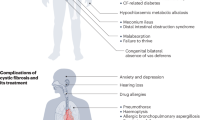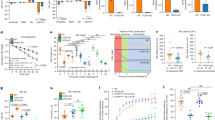Cellular heterogeneity of CFTR expression and function in the lung: implications for gene therapy of cystic fibrosis (original) (raw)
- Review
- Published: 12 March 1998
European Journal of Human Genetics volume 6, pages 12–31 (1998)Cite this article
- 3067 Accesses
- 65 Citations
- 3 Altmetric
- Metrics details
Abstract
Cystic fibrosis (CF) has become a paradigm disorder for the clinical testing of gene therapies in the treatment of inherited disease. In recent years, efforts directed at gene therapy of CF have concentrated on improving gene delivery systems to the airway. Surrogate endpoints for complementation of CFTR dysfunction in the lung have been primarily dependent on correction of chloride transport abnormalities. However, it is now clear that the pathophysiology of CF airways disease is far more complex than can be solely attributed to altered chloride permeability. For example, in addition to functioning as a chloride channel, CFTR also has been implicated in the regulation of other apical membrane conductance pathways through interactions with the amiloride sensitive epithelial sodium channel (ENaC) and the outwardly rectifying chloride channel (ORCC). Superimposed on this functional diversity of CFTR is a highly regulated pattern of CFTR expression in the lung. This heterogeneity occurs at both the level of CFTR protein expression within different cell types in the airway and the anatomical location of these cells in the lung. Potential targets for gene therapy of CF include ciliated, non-ciliated, and goblet cells in the surface airway epithelium as well as submucosal glands within the interstitium of the airways. Each of these distinct cellular compartments may have functionally distinct roles in processes which affect the pathogenesis of CF airways disease, such as fluid and electrolyte balance. However, it is presently unclear which of these cellular targets are most pathophysiologic relevant with regard to gene therapy. Elucidation of the underlying mechanisms of CFTR function in the airway will allow for the rational design of gene therapy approaches for CF lung diseases. This review will provide a summary of the field's current knowledge regarding CFTR functional diversity in the airway and the implications of such diversity for gene therapies of CF lung disease.
Similar content being viewed by others


Cystic fibrosis
Article 08 August 2024

Article PDF
Author information
Authors and Affiliations
- Department of Anatomy and Cell Biology and Department of Internal Medicine at the University of Iowa School of Medicine, Iowa City, Iowa, 52242, USA
Qinshi Jiang & John F Engelhardt
Authors
- Qinshi Jiang
You can also search for this author inPubMed Google Scholar - John F Engelhardt
You can also search for this author inPubMed Google Scholar
Rights and permissions
About this article
Cite this article
Jiang, Q., Engelhardt, J. Cellular heterogeneity of CFTR expression and function in the lung: implications for gene therapy of cystic fibrosis.Eur J Hum Genet 6, 12–31 (1998). https://doi.org/10.1038/sj.ejhg.5200158
- Received: 28 April 1997
- Revised: 14 October 1997
- Accepted: 22 October 1997
- Published: 12 March 1998
- Issue Date: 01 January 1998
- DOI: https://doi.org/10.1038/sj.ejhg.5200158